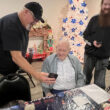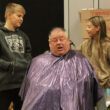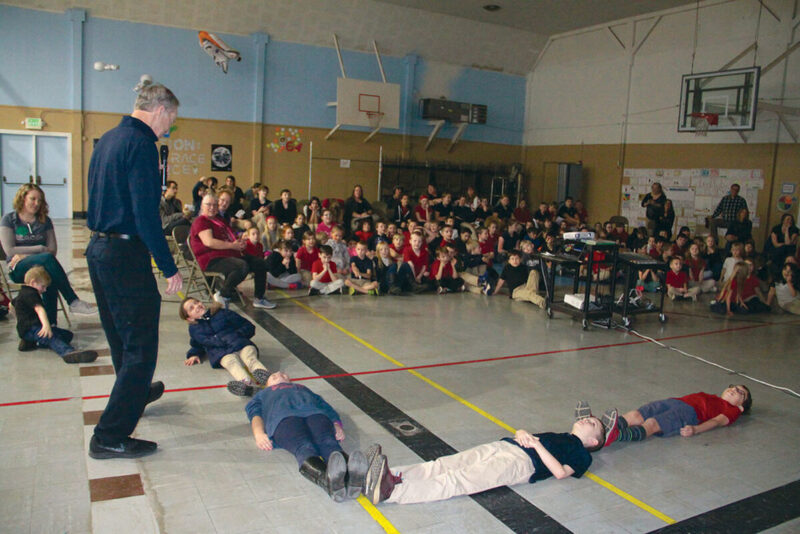Sean C. Morgan
The moon is roughly 25 feet from the earth – that is when the earth is the size of a basketball and the moon is the size of a baseball.
That’s what a group of students at Sweet Home Charter School learned Monday afternoon, Feb. 24, as they held a basketball and a baseball at said distance inside the school gym, to find out just how distant the moon is from the earth.
In reality, the moon is about 240,000 miles from the earth, but that was the point of the exercise.
Astronaut Jim Wetherbee had started things off by asking the students at Sweet Home Charter School how they could tell that’s an accurate way to scale the distance between the earth and the moon. The students shouted out a bunch of answers.
They could use math, one girl said. A boy suggested going to space and finding out.
Wetherbee offered a simpler way to test the scaling: During a full moon, grab a friend, who takes a baseball 25 feet away, and compare the moon to the baseball. Their apparent sizes should match.
The demonstration was part of a presentation by Wetherbee meant to encourage children’s interest in math and science.
“My only point in all of this,” Wetherbee said. “Don’t just believe what I saw. Don’t just google it. Go out into the real world and prove it to yourself.”
His presentation was part of the Charter School’s annual read-a-thon, themed “blast off into a good book” this year.
Wetherbee flew six space shuttle missions, commanding five them, including two aboard the Columbia, two aboard the Discovery, one aboard the Atlantis and his final two-week mission aboard the Endeavour in 2002 to deliver an expansion truss to the International Space Station and exchange crew members aboard the station. That was the last space shuttle mission before the Columbia exploded during re-entry, on Feb. 1, 2003.
Wetherbee now lives in Bend, a couple of hours away, he told the students. “If I had a space shuttle, it would take me a few seconds” to make that trip.
He took a variety of questions from the students and presented an 8½-minute video, the length of time from launch pad to orbit, from his final mission.
One child asked if Wetherbee had ever seen the Milky Way galaxy.
“You would be amazed to see what it looks like from space,” Wetherbee answered.
Another asked him if he knows how big the the “Space Force” will be.
He didn’t, he said, but “if you want to be in the Space Force, study hard.”
He fielded a question about what it’s like to sleep in space.
“It’s really fun,” Wetherbee said. “It’s like being in the water. There’s no pressure points when you’re going to sleep.”
He didn’t want to float into anything, so he always tethered himself.
Wetherbee asked student Madison Olheiser to help him demonstrate. He told her to hold up one arm, like it was floating, and then the other arm. He then asked her to hold one of her legs up.
“Now the last thing you’re going to do is lift the other leg up,” he said, to schoolwide laughter.
Life in space “is a lot of fun,” Wetherbee said. “We do a lot of work.”
But it doesn’t seem like work, he said. He enjoyed being able to “fly” like Superman from one end of the ISS to the other.
He discussed Pluto’s demotion from planet status and the relative size of space, in which he pointed out that the sun’s size in relation to the basketball and baseball would be an 80-foot ball eight-stories tall.
At that scale, Pluto would be in downtown Sweet Home, and the sun would be as far away as Portland.
The nearest star, Proxima Centauri, would be 56,000 miles away, more than twice the circumference of the earth and a little less than a quarter of the way to the moon.
“That’s how big the the solar system is,” Wetherbee said. “That’s how big the universe is.”





